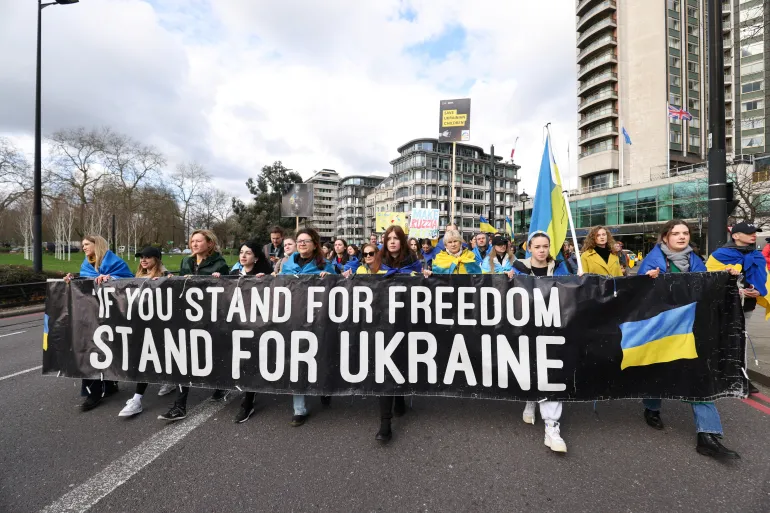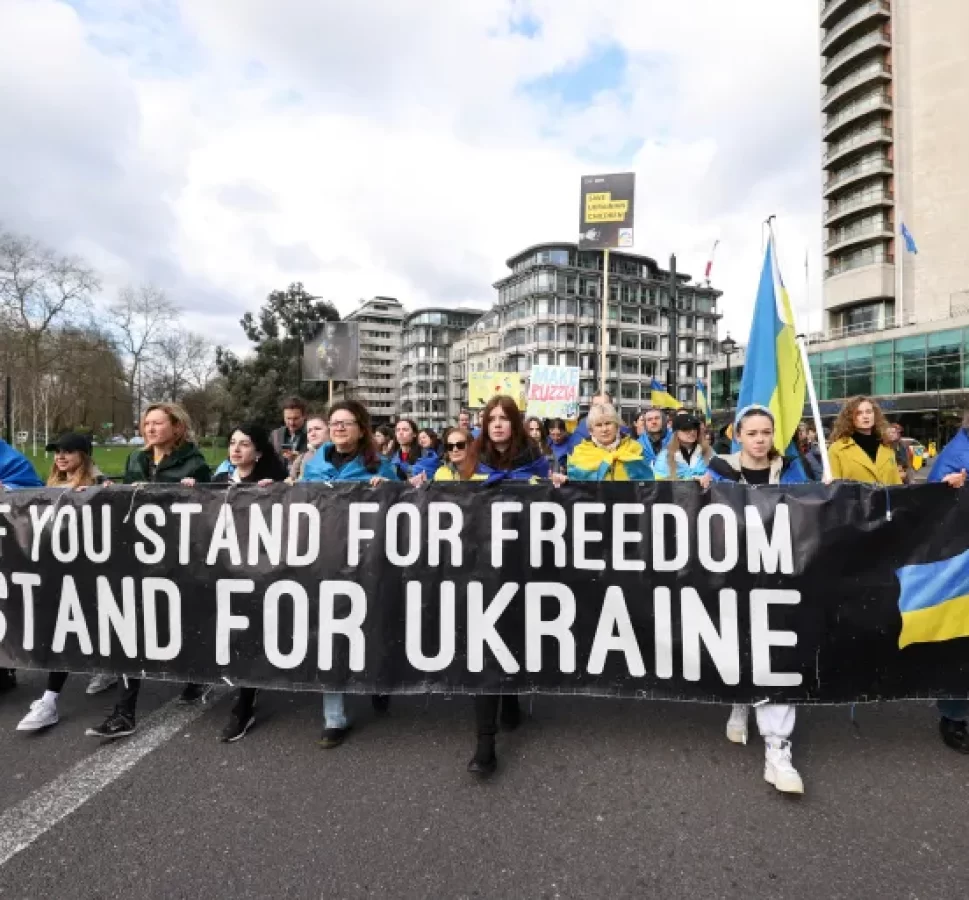
Ukraine is doubling down on remote warfare to smash Putin’s power base and ability to fight.
Ukraine appears to have few resources with which to mount another counteroffensive.
The European Union is upping its military aid from 28 billion euros ($30bn) in the past two years to 21 billion euros ($23bn) this year alone, but that is still not enough to replace United States military aid, stalled in Congress.
The Financial Times reported last month that certain US officials had urged Ukraine to play defence in 2024 and conserve strength for a counteroffensive next year.
“Defensive operations do not necessarily present Ukraine with more opportunities to husband materiel and expand reserves,” wrote the Institute for the Study of War, a Washington-based think tank, in a scathing critique of that advice.
Talking to journalists on Sunday, Ukrainian President Volodymyr Zelenskyy hinted that he would appease conservatives with a summit in Switzerland this spring to thrash out a peace proposal.
But he also said, “We believe that it is only right to get stronger on the battlefield … We do not want any negotiation formats or peace formulas to be imposed on us by countries that are not here today, not at war.”
If Ukraine is to fight for a better bargaining position, many experts feel offence is its only choice.
“We are headed towards a war of attrition, which plays into Russia’s hands,” Vienna-based geopolitical strategist Velina Tchakarova told Al Jazeera.
“Ukraine will launch a military offensive – it is clear,” said Tchakarova, who also predicted Russia’s 2022 invasion.
Ukraine has hinted as much.
“We are doing everything possible and impossible to make a breakthrough,” Rustem Umerov, defence minister, said in the past week.
“Plan 2024 is already there. We do not talk about it publicly. It is powerful, it is strong, it gives not only hope but also will give results in 2024,” he said.
Ukraine still aims to restore the borders Russia recognised in 1991, which means pushing Russian forces out of four partially occupied regions – Luhansk, Donetsk, Zaporizhia and Kherson – and also retaking Crimea.
A survey for the Munich Security Conference showed that at least three-quarters of Ukrainians still back all of these goals.
But how will it be done?
Changing tactics, constant strategy
Last year’s counteroffensive strategy was to capture Melitopol and reach the Sea of Azov.
From there, Ukrainian forces could cut off Russia from Crimea by firing on the Kerch bridge. Had it succeeded, the strategy would have delivered Crimea, Kherson and most of Zaporizhia, and saddled Russian President Vladimir Putin with enormous political pressure to end the war.
Tchakarova said the 2023 counteroffensive failed because it depended on weapons deliveries from allies.
The Kiel Institute for the World Economy, a think tank, measured that weapons commitments in August-October last year were 87 percent lower than during the same period in 2022, the first year of the war.
“This was the decisive factor that led to no significant breakthroughs on the front lines,” Tchakarova said.
This year, Ukraine plans to make as many of its own weapons as possible.
“We are expecting a lot more [help from allies] if we believe the announcements – F-16s, drones and ammunition,” said Tchakarova. “But I don’t expect any serious support,” underlining the wisdom of Ukraine’s new approach.
Ukraine’s tactics are also evolving.
Last June’s counteroffensive was based on mechanised manoeuvres and manpower, but its expenditure in weapons and lives proved unsustainable beyond September.
At about the same time, though, Ukraine launched a series of ranged attacks that proved more sustainable and, in some ways, more devastating to Russia.
In May it struck the Kremlin with drones and followed up with more attacks in the heart of Moscow.
That “produced an incredible sense of worry”, Jade McGlynn, a Russia expert at King’s College London’s War Studies department, told Al Jazeera.
“They were targeting that whole ministry of defence area or the area where the Kremlin elites live, so it was a signal to anyone in that circle that ‘even you are not safe’.”
Surface drones of Ukraine’s own manufacture and Storm Shadow missiles provided by Britain and France have since struck repeatedly in the waters around Crimea, sinking or rendering inoperable half of Russia’s Black Sea Fleet. Aerial drones and missiles have destroyed Crimean air defences, aircraft and the Black Sea Fleet headquarters in Sevastopol.
More recently, drones have targeted oil and gas infrastructure in Russia itself, vital to its export revenue. Russian newspaper Kommersant said refineries had to reduce their output by four percent in January compared with January 2023, because of damage caused by Ukrainian drones.

Zelenskyy said this month that “our task this year is not only to bolster our sky shield and Ukraine’s long-range capabilities to the fullest extent possible, but also to inflict maximum systemic losses on Russia”.
That has been a constant in Ukraine’s strategy.
In September 2022, then-commander-in-chief Valery Zaluzhny said Russia’s ability to strike Ukraine with impunity was “the true centre of gravity of the enemy”, and sought long-range weapons to reciprocate the pain.
“It’s important that Ukrainians continue,” said McGlynn. “Unless [Russians] feel even a thousandth of what Ukraine feels, they’re not going to feel any responsibility to act against it.”
Ukraine is now levelling up this strategy.
It has said it will build 20,000 drones with a range of hundreds of kilometres, suggesting a devastating intended usage rate of 55 a day, and 1,000 drones with a range of more than 1,000km (621 miles) to strike deep inside Russia.
Zelenskyy on Sunday summarised this year’s strategic goals.
“We have to prove that we can deprive Russia of its air supremacy, its financing of aggression and its political power. This is a task for the year,” Zelenskyy told allies gathered in Paris.
Manpower and tactical concerns
Ukraine’s emphasis on remote warfare seems to go hand in hand with a more conservative use of manpower in 2024.
When ground forces commander Oleksandr Syrskyii replaced Valery Zaluzhny as commander in chief this year, there was concern about a return to costlier tactics.
“He is from this Soviet old school of thinking, which is highly artillery-driven and more prone to devote mass to the front, which generates a great deal of concern in Ukraine,” Cambridge University’s Rory Finnin, a Ukraine historian, told Al Jazeera.

Yet Syrskyii belied this assumption on February 17, when he withdrew his troops from the almost surrounded eastern city of Avdiivka. It was a reversal of his tactics in Bakhmut, where he had ordered them to fight a rearguard for every inch of territory.
“Social media showed Russia was caught off guard by the fact that Ukrainian forces pulled back,” said retired Colonel Seth Krummrich, now vice-president of Global Guardian, a security consultancy.
As part of its effort to conserve manpower, Ukraine plans to build a million short-range drones this year, which can deliver small bombs with great accuracy near the front lines, a goal experts have told Al Jazeera is feasible.
Such a rate of production would average about 20,000 bombs a day, and would likely overwhelm Russian volumes. On February 12, Ukraine reported downing 1,157 Russian short-range drones in a week.
Short-range drones might also be the key to equalising artillery power, a step Zelenskyy said was necessary before any new counteroffensive.
“We need to come to those moments when we had appropriate operations, counteroffensive actions, when we went [to a ratio of] 1 to 1.5-3. Then we will be able to push back the Russians,” he said at Sunday’s press conference.
Putin’s chickens
What would be the effect on Russia if Ukraine succeeded in its remote warfare strategy?
Russia has managed to avoid many dire predictions so far.
Despite a mutiny by the Wagner military company last year and numerous antiwar protests, Putin has not been toppled. The rouble did not collapse. Russia circumvented sanctions to sell oil and buy weapons.
However, some experts believe the effects are accumulating.
“I think this year will be the high watermark of Putin’s capacity to influence clearly what’s going on in Ukraine,” British historian Mark Galeotti told the Futucast podcast last month, predicting that “towards the end of this year … we’ll see some very, very large chickens coming home to roost.”
Those chickens include rising household debt, thinning public services and disillusionment with Putin, Galeotti believed: “The system is more and more vulnerable to the unexpected, and the unexpected could come tomorrow or in five years’ time.”
Focus on Crimea?
On Monday, Zelenskyy suggested he might focus directly on Crimea this year.
“We must fight for the full restoration of international law in relation to Crimea,” he said in a statement marking the 10th anniversary of Russia’s annexation of the peninsula.
Ukrainian military intelligence chief Kyrylo Budanov said last month that attacks on Crimea would intensify, and this month predicted, “the peninsula will be brought back”.
This, too, has been a strategic goal since 2022, because Russia maintains five airfields on the peninsula from which it has attacked Ukraine, and uses it to support troops in Zaporizhia and Kherson.
Even if it doesn’t recapture the Crimean peninsula this year, Ukraine can render it unusable as a Russian base of operations using drones and missiles.
Europe’s moment
With US aid stalled, Europe has an opportunity to play a bigger geopolitical role, career British diplomat and lecturer at Cambridge University’s Centre for Geopolitics Suzanne Raine told Al Jazeera.
“For many years now, America has been the first mover that has given us the confidence to do something, and that’s a ridiculous position for us all to be in, frankly,” Raine said.
“If the EU wants to be able to take itself seriously on anything, it needs to be able to galvanise conversations that lead to decisions and action.”
The EU has passed 12 sanctions packages and invited Ukraine to become a member with record speed, but these were low-hanging fruit, said Raine.
“Sanctions are easy and they don’t really work. Accession talks are easy as long as you don’t actually allow them to join,” she said.
Britain has so far been the only European country to upstage the US on new categories of weapons, offering Ukraine tanks in January 2023 followed by medium-range Storm Shadow missiles in May.
Germany has an equivalent Taurus missile it refuses to send Ukraine until the US approves ATACMS.
Raine said she is waiting for the continent to wake up.
“If not now, when?” she said.






